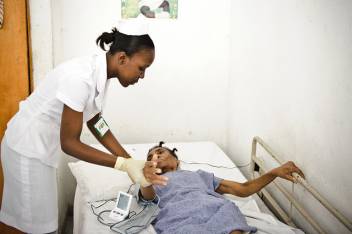 Technological innovations in the forms of medical and assistive devices are essential in contemporary healthcare systems. They play a crucial role in prevention, diagnosis and treatment of various diseases. Medical machines and implants are just a couple of these life-saving devices that have increased life expectancy worldwide over the last few decades.
Technological innovations in the forms of medical and assistive devices are essential in contemporary healthcare systems. They play a crucial role in prevention, diagnosis and treatment of various diseases. Medical machines and implants are just a couple of these life-saving devices that have increased life expectancy worldwide over the last few decades.
Availability of these devices in many parts of the world and for certain populations is challenging though. There are clearly serious issues with cost, technological competence in the context of manufacturing and usage, as well as taxation and transportation concerns.
Older people across the world are certainly a deprived population group when it comes to healthcare. On one hand, there is a greater need for these devices for older people due to higher prevalence of non-communicable diseases. On the other hand, there are gaps related to affordability, illiteracy and lack of policies and information.
The World Health Organization has taken up the lead on addressing this serious need, and as a result organised a consultation on advancing technological solutions for older people. The event took place in Kobe, Japan in last month and was attended by a range of medical experts, government representatives and civil society.
The discussions focused on addressing barriers in the context of product development, delivery of devices, governance and issues at the end-user’s level. Older people’s special needs were considered and brought into future plans.
Lack of medical devices
A review by the University of Melbourne, Australia studied major health conditions contributing to Disability Adjusted Life Years (DALYs), which is the sum of years of potential life lost due to premature mortality and the years of productive life lost due to disability.
This study included sense organ disorders, neuropsychiatric conditions, cardio-vascular diseases, respiratory diseases, musculoskeletal diseases and diabetes in the context of Western Asia Pacific region. The findings highlighted serious gaps on availability, cost and quality of devices in most countries, as well as inadequate policies.
The discussion led to a number of recommendations. These highlighted the need to list devices at the national level, promote awareness of the technical specifications of devices and finance reforms aimed at reducing the cost, budgetary allocations and technology transfer (patenting).
Furthermore, the recommendations emphasised the importance of training interventions both for end-users and service providers, as well as developing monitoring and evaluation systems at country level to keep track of the progress.
Strong role for HelpAge global network
In the path ahead, the HelpAge global network should clearly see strong roles for itself in community-based research, training interventions, advocacy at the national level and monitoring and evaluation.
As future key steps, a number of important events and dialogues are lined up in 2013. The UN High Level Meeting on Disabilities in New York in September, the Second Global Medical Devices Form in Geneva in November and Global Form on Innovation for Healthy Ageing in Kobe in December are some of these key opportunities. Hopefully, these forums will lead to concrete policy level work and implementation strategies affecting millions of older people in need of medical devices.
The demographic transition the world is witnessing brings the need of medical devices for older people into the forefront of future public health discourse.
Read more about HelpAge’s work on health and non-communicable diseases.
